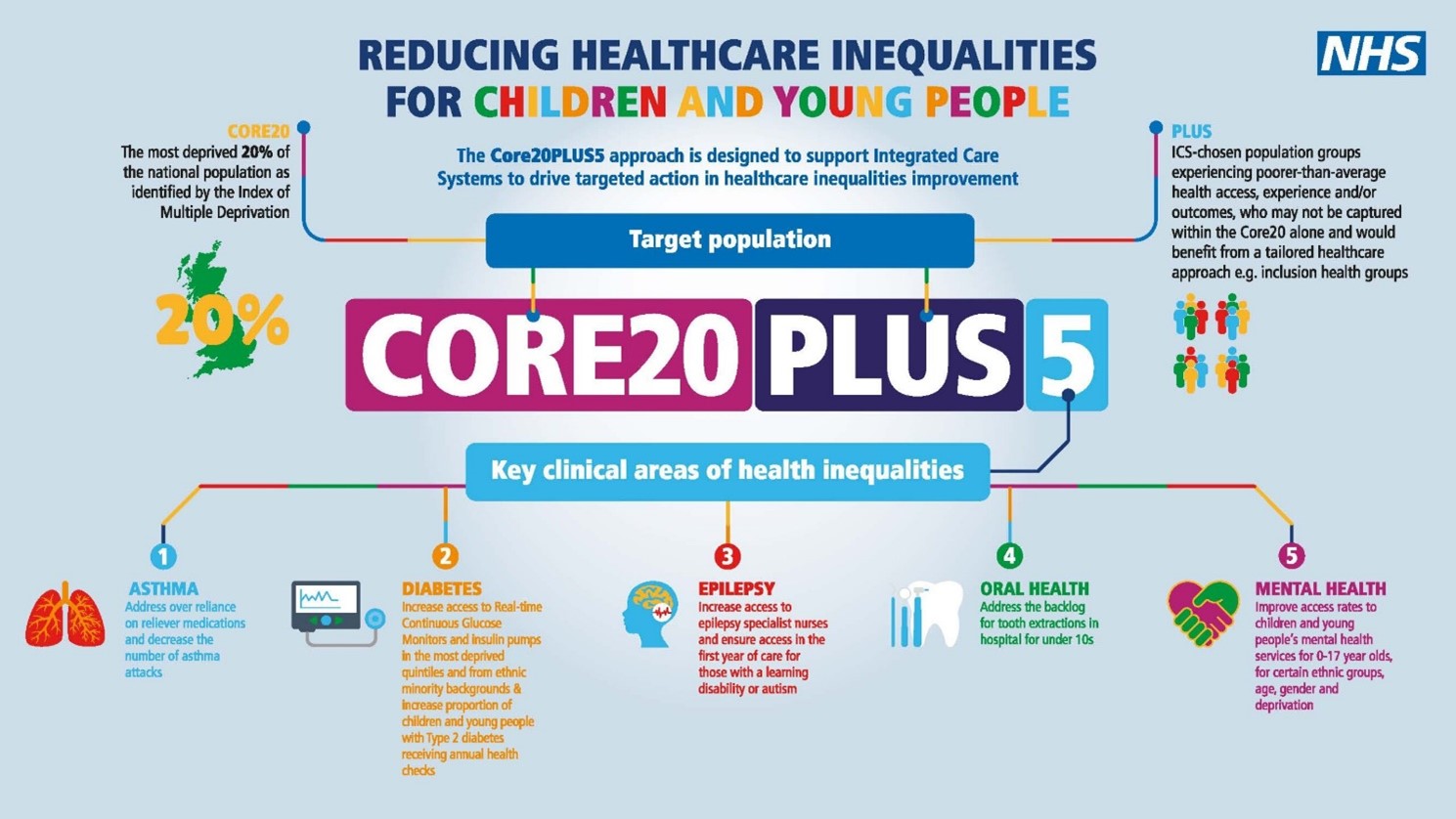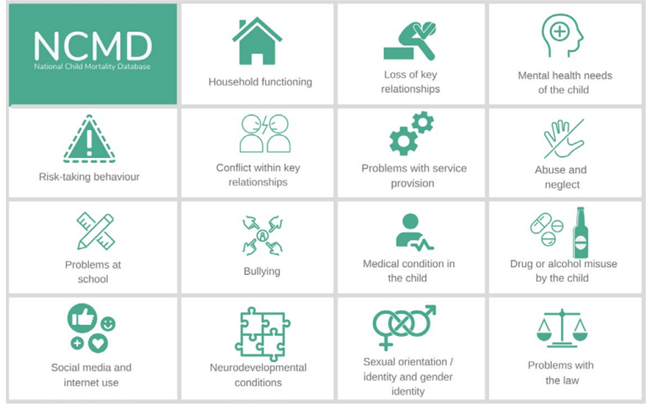Inequalities in mental health
There are well-established risk factors for poor mental health in young people. These factors were detailed in the Children and Young People’s Mental Health Strategy (Cambridgeshire and Peterborough Integrated Care System, 2022f) and the Mental Health and Wellbeing Pre-birth to Age 25 years Needs Assessment November 2019 (Hedges et al., 2019).
- NHS England has developed CORE20PLUS5 model to understand health inequalities. ‘Improving access rates to children and young people’s mental health services for 0–17-year-olds, for certain ethnic groups, age, gender and deprivation’ is a key priority of this model (NHS England, 2023a)
Figure 28: CORE20PLUS5 model for understanding healthcare inequalities for children and young people. Image source: NHS England
Chapter One of this needs assessment includes more information on relevant wider determinants of health in Cambridgeshire and Peterborough. Chapter Two covers population groups that are more likely to experience inequalities in mental health, in terms of: increased risk of experiencing mental health conditions, risk factors, and inequalities in the access, experience and outcomes from mental health services. This chapter (Chapter Three) covers adverse childhood experiences.
Socioeconomic deprivation
- Deprivation: 1 in 5 children in Peterborough and Fenland live in income deprived households, which is a significantly higher level than the national average (Office for Health Improvement and Disparities, 2022).
- Poverty and financial insecurity: there are over 25,000 children (under 16s) in Cambridgeshire and Peterborough living in low income families (Office for Health Improvement and Disparities, 2022)
Equality and diversity
- Ethnicity: 30% of school pupils in Cambridgeshire and 56% in Peterborough classified themselves as belonging to an ethnic group other than White British in the 2022/23 school year (Department for Education, 2023b).
- Gender: national data shows that 1% of 16- to 24-year-olds are transgender (Office for National Statistics, 2022a). There is a lack of data on younger age groups.
- Sexuality: national data states that 7% of 16- to 24-year-olds are LGB+ (Office for National Statistics, 2022c). There is a lack of data on younger age groups.
- Refugees and asylum seekers: there is a lack of local data on the number of children who are refugees or seeking asylum (Cambridgeshire and Peterborough Integrated Care System, 2022f).
- Disability: there are 19,000 school pupils in Cambridgeshire and Peterborough with a statutory special education need (SEN) plan or receiving SEN support (Cambridgeshire and Peterborough Integrated Care System, 2022f).
- Learning disability: The mental health needs of children and young people with learning disabilities will be covered in the Cambridgeshire and Peterborough Learning Disabilities Needs Assessment (published in 2024).
- Neurodiversity: it is estimated that there are over 2,700 autistic people aged between 5 and 24 in Cambridgeshire and Peterborough (Cambridgeshire County Council & Peterborough City Council, 2021). There will be a specific chapter of the mental health needs assessment focusing on neurodiversity (published in 2024).
- Care experienced people: in 2022, there were 597 children in care in Cambridgeshire and 354 children in care in Peterborough (LG Inform, 2022).
- Young carers: it is estimated that there are 5,000 young carers aged between 11 and 17 in Cambridgeshire and Peterborough (Cambridgeshire and Peterborough Integrated Care System, 2022f).
Severe multiple disadvantage
‘The young people we are focusing on are unlikely to self-diagnose mental health difficulties or self-refer themselves for treatment and help. Already under extreme pressure, often struggling with school and most at risk of being targeted by those wishing to exploit them, these young people need mental health support that seeks them out, delivers in a way that meets their needs in the community and is there for the long term.’ – Children and Young People’s Mental Health Coalition (Children and Young People’s Mental Health Coalition & Centre for Mental Health, 2022)
- Contact with the criminal justice system, including the wider needs of young offenders: there were 119 first time entrants to the youth justice system (aged 10 to 17) in 2021 (Office for Health Improvement and Disparities, 2022).
- Homelessness: 2381 young people (aged 16 to 24) in Cambridgeshire and Peterborough approached by their local authority because they were homeless, or at risk of being homeless, in 2021/21 (Centrepoint, 2023).
- Victims of crime: national data suggests that 12.0% of children under 12, and 18.4% of young people aged 11 to 17, have witnessed domestic abuse or threatening behaviour at home (Moroz, 2021).
- Substance use, including parental substance use: there were 185 hospital admissions due to substance use in young people (aged 15 to 24) from 2018/19 to 2020/21 (Office for Health Improvement and Disparities, 2022).
- School exclusion: it is estimated that almost all children who are excluded from school have some form of mental health condition (Gill et al., 2017).
What are the largest inequalities in children and young people’s mental health?
An analysis of inequalities in the two contact access rate (the number of children and young people who have received at least two contacts with a mental health service, following a referral) in 2020/21 showed that that greatest inequalities in access to services in Cambridgeshire and Peterborough were by age and ethnicity. Inequalities by deprivation and gender were larger in Cambridgeshire and Peterborough than in other areas in the East of England.
- This graph shows the percentage needed to increase the number of treated children and young people from the group on the left (e.g. boys) to have the same treatment access rate at the group on the right (e.g. girls). The greater the percentage, the larger the inequality.
- Ethnicity is unknown for 13.2% of treated patients; but even if we assume these patients all have a White ethnic background, there would still be an inequality. The grouping of ethnic groups into ‘non-white ethnic minorities’ is likely to have masked underlying differences within this group.
- This analysis was limited as it did not consider other factors that may be linked to inequalities (such as the presence of long-term health conditions) or overlapping experiences of inequalities (such as comparing access rates between boys living in highly deprived areas to girls living in less deprived areas).
Figure 31: Inequalities in the two contact access rate in the East of England, 2020/21. Image source: Cambridgeshire and Peterborough Children and Young Persons Mental Health ICS Data Insight Pack (June 2022). Note: EoE is the average for the East of England; BLMK is Bedfordshire, Luton and Milton Keynes Integrated Care System (ICS); C&P is Cambridgeshire and Peterborough ICS; HWE is Hertfordshire and West Essex ICS; MSE is Mid and South Essex ICS; N&W is Norfolk and Waveney ICS; and SNEE is Suffolk & North East Essex ICS.
Wider research tells us that:
- The strongest risk factors for depression in young people are a family history of depression and psychosocial stress (with chronic severe stresses, such as negative family relationships and bullying, being the most impactful) (Thapar et al., 2012).
- Children and young people who were female, in their teenage years, or had neurodiverse or chronic physical health conditions were more likely to experience poor mental health in the first year of the COVID-19 pandemic (Samji et al., 2022b).
What are the risk factors for suicide?
‘The death of a child by suicide is an unimaginable tragedy. A young life is lost, a family is devastated, the society where it happens is diminished. The risk, it should be stressed, is low but the need to improve prevention could not be higher.’ – National Child Mortality Database (National Child Mortality Database, 2021)
The National Children Mortality Database analyses child deaths by suicide. The most recent report analysed the 108 probable suicides of children and young people (under 17s) between April 2019 and March 2020, which accounts for around 2 deaths per week (National Child Mortality Database, 2021). Suicides were more common in boys than girls, and 78% of deaths occurred in 15- to 17-year-olds (National Child Mortality Database, 2021). Common risk factors included factors relating to household functioning (such as parental separation and domestic abuse), loss of key relationships and mental health needs (National Child Mortality Database, 2021).
Figure 32: Factors present in suicides, as identified in child death reviews in England from April 2019 to March 2020. Image source: National Child Mortality Database
More recent data shows that deaths by suicide in children and young people did not increase during the first stage of the COVID-19 pandemic (April to December 2020) (Odd et al., 2021).
Additional resources
- Vulnerability in childhood: a public health informed approach
- Tackling mental health disparities: Ten evidence-based actions that government could take in the forthcoming white paper
- Reducing health inequalities faced by children and young people
- Making a Difference to Young People’s Lives through Personalised Care: Mental Health Inequalities and Social Deprivation
- The importance of ethnicity for understanding young people’s experiences of health inequalities
- Young Person’s Toolkit
- Language matters: How to talk about health inequalities in the context of young people
- Inequities in children and young people’s mental health services | The Strategy Unit
- No child left behind: Understanding and quantifying vulnerability
- National Institute of Health Research’s framework for public mental health
References
Full list of references is included at the end of this chapter.



